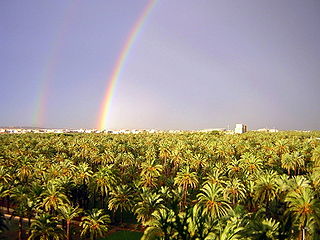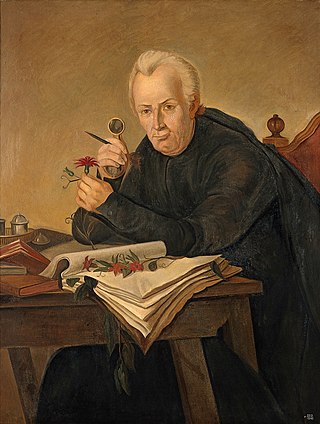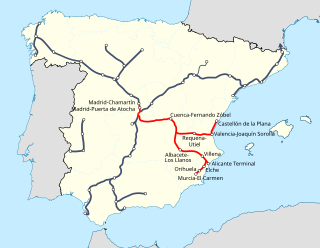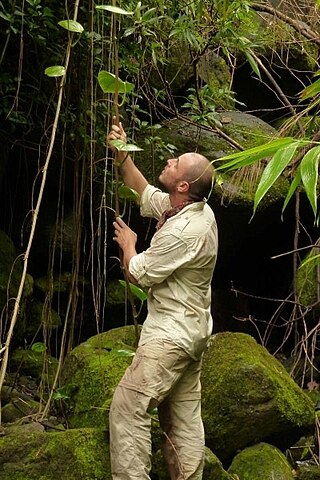
Elche (, Spanish:[ˈeltʃe]; Valencian: Elx,, , Valencian:[ˈɛʎtʃ] is a city and municipality of Spain, belonging to the province of Alicante, in the Valencian Community. According to 2014 data, Elche has a population of 228,647 inhabitants, making it the third most populated municipality in the region and the 20th largest Spanish municipality. It is part of the comarca of Baix Vinalopó.

The Palmeral or Palm Grove of Elche is the generic name for a system of date palm orchards in the city of Elche, Spain.
Serranía de la Macarena is an isolated mountain range located in the Meta Department, Colombia. It was named after the Virgin of Hope of Macarena. The mountains are separated by about 40 km (25 mi) at their northern extreme from the East Andes. The range is orientated from north to south and is 120 km (75 mi) in length and 30 km (19 mi) wide. The highest peak reaches 2,615 m (8,579 ft) and is the highest point of the Orinoquía Region. The first national reserve in Colombia was established in the central part of the mountain range in accordance with a Congressional Law promulgated in 1948. The status of National Natural Park was designated in 1971 and the protected area encompasses 6,200 km2 (2,400 sq mi).

José Celestino Bruno Mutis y Bosio was a Spanish priest, botanist and mathematician. He was a significant figure in the Spanish American Enlightenment, whom Alexander von Humboldt met with on his expedition to Spanish America. He is one of the most important authors of the Spanish Universalist School of the 18th century, together with Juan Andrés or Antonio Eximeno.

A traditional Spanish garden is a style of garden or designed landscape developed in historic Spain. Especially in the United States, the term tends to be used for a garden design style with a formal arrangement that evokes, usually not very precisely, the sort of plan and planting developed in southern Spain, incorporating principles and elements from precedents in ancient Persian gardens, Roman gardens and Islamic gardens, and the great Moorish gardens of the Al-Andalus era on the Iberian Peninsula.

The Madrid–Levante high-speed network is a network of high-speed rail lines that connects Madrid with the Mediterranean coast of the Levante Region, specifically with Castilla-La Mancha, the Valencian Community and the Murcia Region autonomous communities.

Carros de Foc is a street theater company with its headquarters in Alicante (Spain). Their unique traits in the shows are the Giant Mobile Sculptures that are combined with different artistic disciplines in order to create surprising shows. The Company has represented Spain in different Street Theater Festivals around Europe and Africa.

The Alhorines Valley is a valley and a major grain producing area of the provinces of Albacete, Alicante and Valencia in Spain. Historically it was long disputed between the towns of Caudete and Villena. A large solar thermal power plant has recently been built in the valley. The lesser kestrel was re-introduced in 1997. Conservation measures have been taken to minimize impact of the power plant on the birds.

A vertical ecosystem is an architectural gardening system developed by Ignacio Solano from the mur vegetal created by Patrick Blanc. This new approach enhances the previous archetype of mur vegetal and considers the relationship that exists between a set of living organisms, biocenosis, inhabiting a physical component, biotope. The system is based on the automated control of nutrients and plant parameters of the original wall, adding strains of bacteria, mycorrhizal fungi and interspecific symbiosis in plant selection, creating an artificial ecosystem from inert substrates. The system was created in 2007 and patented in 2010.
La Verdad is a daily newspaper based in Murcia, Spain. It is the largest newspaper of the Murcia province as well as of the Albacete province. During its existence it had presence in the Alicante province, being discontinued from the Land of Valencia in 2017.

Gardening in Spain reflects the different styles of Spanish art, including influences from Roman, Islamic, Italian, French, and English gardens. Modern Spanish gardening emphasize gardens and their surroundings, focusing heavily on both urban horticulture and landscape architecture.

Luis José Barcala Sierra is a lawyer and the current mayor of Alicante, Spain since 19 April 2018.
In the run up to the 2019 Spanish local elections, various organisations carried out opinion polling to gauge voting intention in local entities in Spain. Results of such polls for municipalities in the Valencian Community are displayed in this article. The date range for these opinion polls is from the previous local elections, held on 24 May 2015, to the day the next elections were held, on 26 May 2019.
Frutos María Martínez is a Spanish sculptor and painter. He lives and works in Alicante, Spain.

Prensa Ibérica Media, S.L., or simply Prensa Ibérica, is a Spanish mass media company owned by Javier Moll. It primarily owns regional newspapers.

The Cartagena Botanical Garden is located in the hills above Cartagena, in Turbaco, Bolívar, Colombia. It stretches over nine hectares, of which three hectares are natural tropical dry forest and six hectares are dedicated to botanical collections.

The parks and gardens of Barcelona cover an area of 2,784 hectares. Its management depends on the Municipal Institute of Parks and Gardens of Barcelona, a body under the Barcelona City Council. Since the 19th century —and especially in the 20th century— Barcelona has been committed to the development of green areas in the city, and is currently one of the European cities with the most roadside trees. In 2001 the Institute of Parks and Gardens received ISO 14001 certification for the conservation and management of green spaces and public roadside trees.

The Jardín del Turia is a public urban park located in the former riverbed of the Turia River in the city of Valencia, Spain. The park spans approximately 136 hectares, with plans to expand to 160.5 hectares in the future. It stretches nearly 8.5 kilometers in length, which will extend to almost 10 kilometers upon completion of the final section, with an average width of about 160 meters. It is one of the largest purely urban gardens in Spain.















